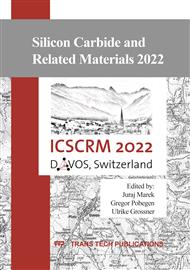p.27
p.35
p.43
p.51
p.57
p.63
p.69
p.75
p.85
High Sensitivity Surface Defect Inspection of SiC and SmartSiCTM Substrates Using a DUV Laser-Based System
Abstract:
SmartSiCTM technology enables the supply of cost-effective and high-quality substrates to support the manufacturing of Silicon Carbide (SiC) Power Devices and the transition to High Volume Manufacturing (HVM) [1]. As detailed in [2] SmartSiCTM is prepared using a poly-crystalline handle wafer, it combines the benefit from both an optimized high quality epi-ready 4H-SiC layer and an ultra high conductivity handle material. Smart CutTM technology can be extended to SiC 200mm substrates and first SmartSiCTM 200mm sample has been prepared [2].SmartSiCTM substrates crystal quality is inherited by donor wafers [1, 2] and do not require a systematic control, enabling a new defects monitoring strategy, focusing on surface defects.This paper describes how a commercially available DUV inspection system was utilized for high sensitivity, high-throughput inspections of 150 and 200 mm 4H-SiC and SmartSiCTM substrates, for the HVM environment. The KLA Surfscan® SP A2 unpatterned wafer inspection system offers the opportunity to complement other inspection technologies to optimize SiC substrate defect control, with low threshold detection, below 150 nm.
Info:
Periodical:
Pages:
57-61
Citation:
Online since:
May 2023
Permissions:
Share:
Citation:



